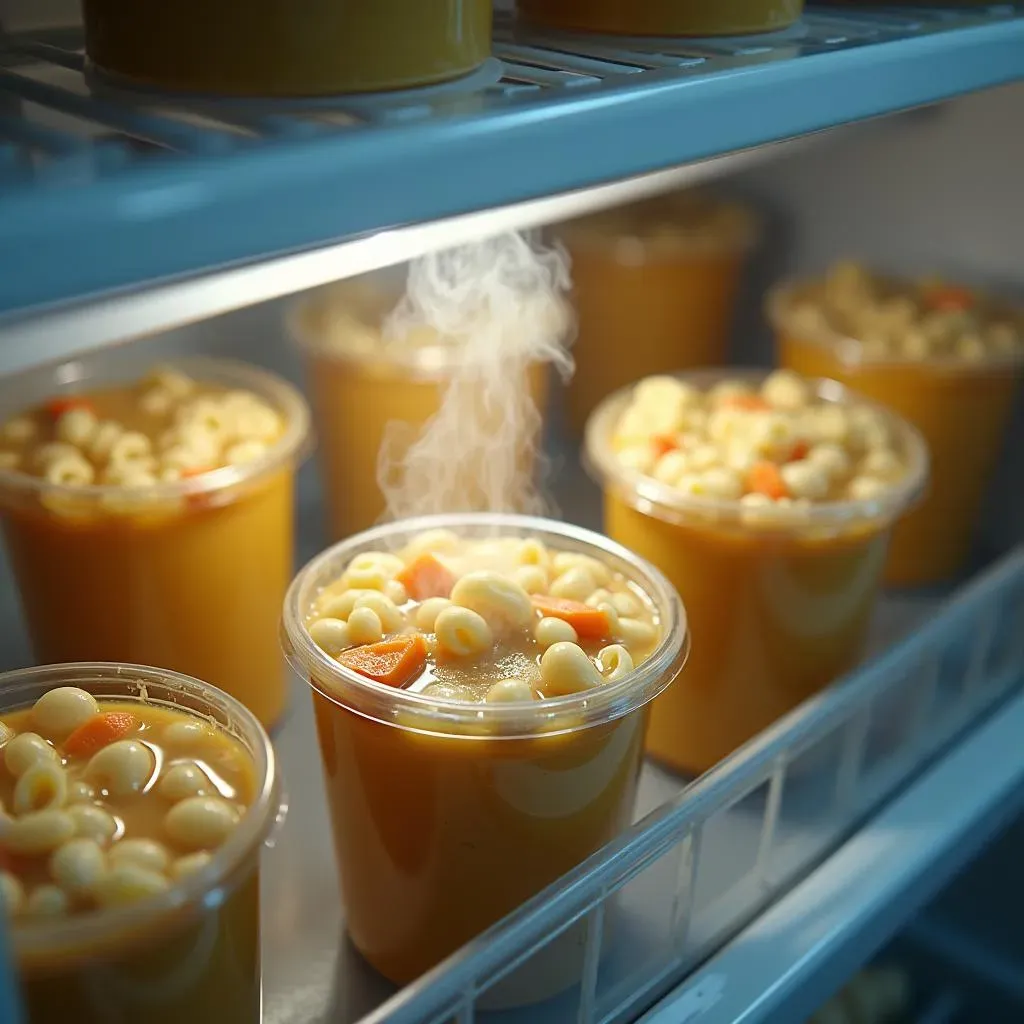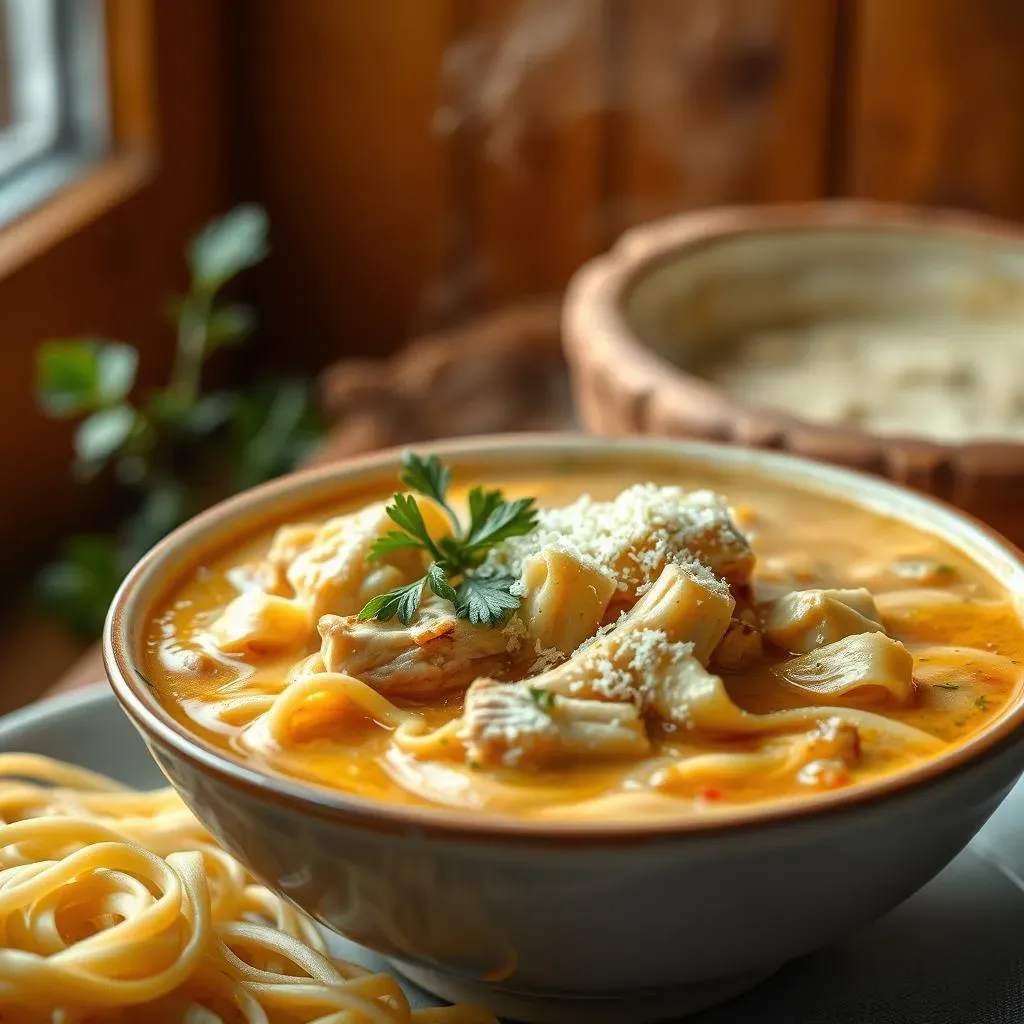Table of Contents
Ever made a big batch of chicken noodle soup, only to wonder, "Now what?" Figuring out how to store chicken noodle soup properly can be a real head-scratcher. I've been there, staring at a pot of deliciousness, unsure if it belongs in the fridge or if it needs a deep freeze. Nobody wants a soggy noodle mess or, worse, a science experiment in their refrigerator. This article isn't just about shoving leftovers in a container. We are going to explore the best ways to keep your soup tasting great whether you plan on eating it tomorrow or months from now. We'll tackle the fridge for short-term storage, the freezer for longer hauls, and, most importantly, how to prevent those dreaded mushy noodles. Get ready to become a chicken noodle soup storage expert, because nobody likes wasted soup.
The Fridge is Your Friend: ShortTerm Storage for Chicken Noodle Soup

The Fridge is Your Friend: ShortTerm Storage for Chicken Noodle Soup
Cooling Down is Key
So, you've got leftover chicken noodle soup. First things first, let's get it cooled down. Don't just chuck that steaming pot straight into the fridge. That's a recipe for disaster, or at least, a warm fridge and potentially unsafe food. The goal is to cool it quickly to avoid bacteria growth. Think of it like this, you wouldn't leave a hot car running all day, would you? Same principle applies here.
I usually transfer my soup to a shallow container to help it cool faster. If you have a big pot, divide it up into smaller containers, that way the heat disperses more quickly. Don't cover it until it's cooled down either. Covering it while hot traps the heat, making it take even longer to cool down. Once it's cooled you can go ahead and put a lid on it and move it to the fridge.
Do | Don't |
|---|---|
Transfer to shallow containers | Put hot soup directly into the fridge |
Let cool uncovered | Cover while hot |
Divide into smaller portions | Leave in one big pot |
Fridge Life: How Long is Too Long?
Okay, your soup is now chilling in the fridge. How long can it hang out there before you should be worried? Generally, chicken noodle soup is safe to eat for about 3 to 4 days when stored properly in the fridge. After that, you are pushing your luck. I mean, we've all played the "sniff test" game, but let's be real, sometimes, you can't tell if it's gone bad.
It's better to be safe than sorry, especially when dealing with food. I always try to label my containers with the date, so I know when it's time to either eat it or toss it. If you're not sure if it's okay, don't risk it. Nobody wants a tummy ache because of old soup. When in doubt, throw it out!
- 3-4 days is the max for fridge storage
- Label containers with the date
- When in doubt, throw it out!
Freezing for Later: A Guide to LongTerm Chicken Noodle Soup Storage

Freezing for Later: A Guide to LongTerm Chicken Noodle Soup Storage
Freezing 101: Containers and Cooling
Alright, so you've got more soup than you can handle in a few days? Freezing is your superhero move. But don't just toss it in any old container, because you will regret it later. Think about what you'll use to store it. I prefer freezer-safe containers with a good seal. Those flimsy plastic bags? They are not your friends here.
Also, remember how we cooled the soup before putting it in the fridge? Same deal applies here. You don't want to put hot soup in the freezer because it will raise the temperature of everything else in there. That's not a good idea. Let the soup cool down a bit before you freeze it. It'll be much happier, and so will your freezer. I usually portion the soup into single serving containers, so I can grab one for lunch whenever I want.
Freezing Dos | Freezing Don'ts |
|---|---|
Use freezer-safe containers | Use flimsy plastic bags |
Cool soup before freezing | Freeze hot soup |
Portion into single servings | Freeze in one big container |
The Freezer Timeline: How Long Will it Last?
Okay, so you've got your soup all snug in the freezer. Now, how long can it hang out there? Generally, chicken noodle soup can stay good in the freezer for about 2 to 3 months. After that, the quality starts to go downhill. It won't necessarily be unsafe to eat, but the taste and texture won't be as good. I like to put a label on the container with the date I froze it, so I know when it's approaching its freezer expiration date.
Also, keep in mind that the freezer isn't a magical time machine. The sooner you eat it, the better it's going to taste. Don't leave it in there for a year and expect it to be as good as the day you made it. If you see freezer burn on the soup, it's still edible but the texture won't be the best. So, try to eat your frozen soup within that 2-3 month timeframe for optimal enjoyment.
- Frozen soup lasts 2-3 months
- Label containers with the freezing date
- Eat sooner rather than later for best taste
Noodle KnowHow: Keeping Your Chicken Noodle Soup From Getting Soggy

Noodle KnowHow: Keeping Your Chicken Noodle Soup From Getting Soggy
The Dreaded Sog: Why Noodles Go Mushy
Okay, let's talk about the real villain of leftover chicken noodle soup: soggy noodles. No one likes them, and they can ruin an otherwise perfect meal. The main reason noodles get mushy is that they continue to absorb liquid even after they're cooked. When you leave cooked noodles sitting in broth, they just keep on soaking it up, and they get bigger and softer until they become a sad, gloppy mess. It's like leaving a sponge in a bucket of water.
The type of noodle also makes a big difference. Thin noodles like vermicelli or angel hair are more prone to getting mushy than thicker noodles like egg noodles or rotini. So, when you're making soup, consider the type of noodle you are using. If you know you are going to have leftovers, perhaps choose a thicker noodle, or try adding the noodles separately when you are reheating the soup.
Cause of Soggy Noodles | Solution |
|---|---|
Noodles continue to absorb liquid | Store noodles separately from broth |
Thin noodles get mushier faster | Use thicker noodles |
Noodles sit in broth for too long | Add noodles when reheating |
The Separate but Equal Approach
So, how do we avoid the dreaded soggy noodle? The best trick is to store your noodles and broth separately. I know it may seem like a bit of extra effort, but trust me, it's worth it. When I make a big batch of soup, I always cook my noodles separately, and then add them to the soup when I am ready to serve. That way, I can store the broth and veggies in one container and the noodles in another.
When it's time to reheat, I just add the desired amount of noodles to the broth and heat it up. This ensures that your noodles stay perfectly cooked and not mushy. It's like a magic trick, but really, it is just good planning. It's all about keeping things separated until the last minute. This way, you can enjoy your soup with the noodles tasting just as good as the day you made it.
Adding Noodles at Reheat: Timing is Everything
Okay, so you've stored your noodles separately, great job! Now, let's talk about the best way to add them back in when you're reheating the soup. The key here is timing. You don't want to add the noodles too early, or they will start to absorb the broth and turn to mush. I usually add my noodles to the pot of simmering broth about 5 minutes before serving. This is usually enough time to heat them through without making them too soft.
Another tip is to slightly undercook the noodles when you first cook them. This way, when you reheat them in the broth, they will finish cooking and be perfect. It's like giving them a little head start. If you're freezing your soup, I would definitely recommend to leave the noodles out entirely and cook them fresh when you reheat the soup. You will have a much better result and avoid the mushy noodle catastrophe.
- Add noodles 5 minutes before serving
- Slightly undercook noodles when preparing
- Cook fresh noodles when reheating from frozen
